Thinking about developing an interactive touchscreen experience for your business? Perhaps you want a touchscreen experience for an event, exhibition or tradeshow or maybe a more permanent fixture, such as for a customer sales centre or marketing suite. But you want to know more about the process first?
So, if you’re wondering how an interactive experiences platform and developer can help you go from idea to finished experience – and who needs to be involved and when – this article will shed a bit more light on the subject.
The creation process may vary between different agencies or developers, but as touchscreen specialists ourselves, we’re going to talk you through our own process, so you can have a better idea of what to expect.
But first…
What to consider first
There are a lot of factors to consider when creating the best interactive touch screen display and ideally you should begin this process before you even get in touch with a specialist.
You should carefully pinpoint what you’re looking to achieve with your touchscreen solution – what does success look for you, and think about how those goals are going to line up with those of your audience. For example, are you looking to spark interest in a new product, or capture leads at an event?
Regardless of what you need to achieve, begin by envisioning how you might go about creating an engaging and enjoyable experience that is going to attract then entice users into doing what you need them to do – what can you offer them in return for their efforts?
You also need to consider the space your touchscreen is going into – will it fit, what kind of stand do you need, do you need a bespoke enclosure, along with the type of hardware you’re going to need. Will there be internet in the location? Will you need signage? Will you need the touchscreen to interact with other things, such as lights, use object recognition or connect up to company data on servers or other websites?
Some people aren’t sure what’s possible, and to what extent. If that sounds like you, the next step is to find an interactive touchscreen specialist or developer who can listen to your needs and tell you more about what’s possible and give you some guidance.
TIP: We’d recommend you follow the steps in our recent blog: ‘5 Steps to Finding the Best Interactive Touchscreen Developer for Your Project’ to help you find the best interactive agency or specialist for the job.
1. What’s your objective?
Before starting anything you need to outline your objectives and business case for the interactive.
- What are you ultimately trying to achieve?
- what does success look?
- How will your experience benefit your company and your customers?
- What actions do you want your audience take when using or after the experience?
- What impression do you want to leave them with?
- What information will they need in order to make an informed decision or do what you want them to do?
These are just a few of the questions you should be asking before starting to engage with a touchscreen specialist or even pulling content and ideas together.
Once you’ve established these you can start to engage with some specialist developers.
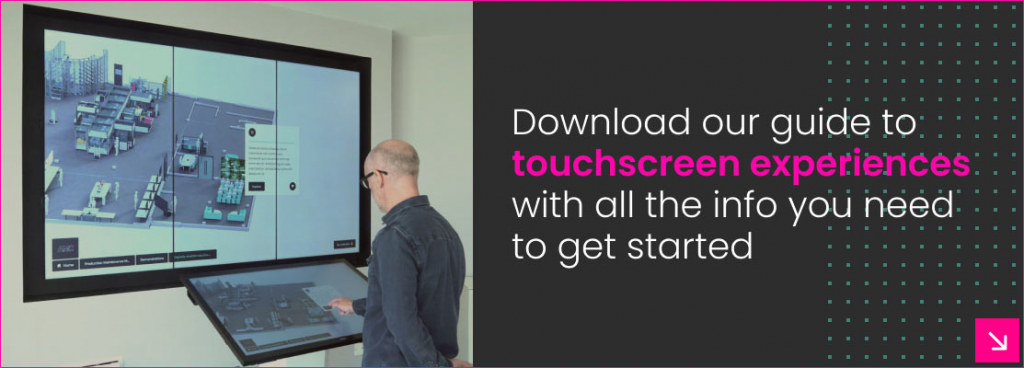
2. Speak to 2 – 3 touchscreen specialists
When we say ‘touchscreen specialists’, we don’t mean someone who’s experienced in web development, software or hardware. We mean a company who specialises in developing interactive experiences – which are really quite different from the above.
This is because an interactive touchscreen is a completely different user experience to something you’d find on a website or app. There’s so much more to consider when developing an interactive experience to ensure that it’s going to be engaging and easy to use.
The larger size of the screen alone is an immediate game-changer, as it means the layout of the design, content and navigation need to be very different from what you’d find on a website. It’s also important to keep content dynamic and engaging for people.
You’ll want the best interactive touch screen display that reflects your brand in terms of design and language – which is so much better than using a slightly modified one-size-fits-all template that only partially does what you need, or just dropping your website on a touchscreen and letting people get on with it.
Speaking to two or three touchscreen specialists will give you a better idea how each might handle your project. They should ask you all the right questions, and you should, in turn, have some questions of your own – you can check out what you should be asking in this blog: ‘5 Steps to Finding the Best Interactive Touchscreen Developer for Your Project’
3. Request a proposal
Once you’ve discussed everything with your chosen touchscreen specialists, and you’ve gone over the most important questions (including their experience, whether they can provide the hardware, and how long you can expect your solution to take), you should be feeling happy enough to request a proposal to see what they come up with.
The proposal should include an outline quote, rough timescales for each stage of the process, and a range of examples to give you some ideas or inspiration for what could potentially be achieved with your experience.
From there, and together with your touchscreen specialist (assuming you’re happy with what they come up with!), you should be able to refine the brief until you’re 100% happy to go forward.
TIP: Don’t forget to make it clear early on whether or not you want your touchscreen content to be updateable for future use!
It could be that you receive two or three briefs, and you make your final decision based on what your developer or specialist comes back with – as well as how they respond to your ideas and questions. They should hopefully make this process as easy and stress-free as possible for you.
4. Sitemap, storyboard and design mock-ups
Specialist appointed you can now start the process of developing the experience with them. Here are the steps we go through.
Your content and the order in which it is presented to your audience is the first thing you need to plan. In order to do this we create sitemaps for the interactive.
A sitemap helps you design the overall structure of your experience, from the homepage through to the content pages. This is an important step as it allows you to check that all the information you want your audience to have access to has been accounted for and see where any structural or content gaps are. Sitemaps are commonly used to map out websites and you can create them in powerpoint or good old pencil and paper, the below image is an example of what one looks like.
Once you’ve agreed your sitemap the next step is to create the storyboards. Think of the storyboard as a basic ‘black and white’ prototype of your touchscreen experience – by focusing on functionality, rather than design, you can review the navigation, general layout and structure.
Is there space for all of your content? Do you need any pop-up windows or hotspots? Can people navigate around easily? Sometimes these storyboards will be interactive so you will be able to click through them in a similar way to the final experience which will help you to get an idea on the overall interactive functionality.
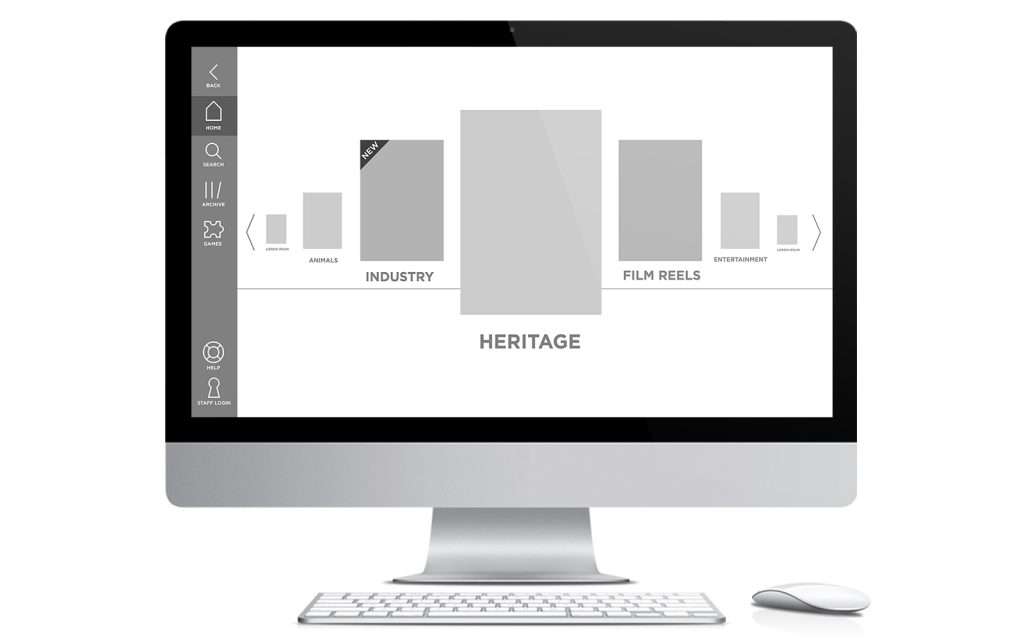
They also help you decide on the user journey, the steps that a customer will take as they tap through your experience and explore your stories.
Sitemaps will take a couple of days to produce, and storyboards will take roughly 1-2 weeks.
Based on the storyboard and design they’ve created, your specialist should provide design concepts for the overall look, feel and branding of the experience. They should look at the overall design and theme, along with any central visual devices to help tie the experience together.
This is the stage before your touchscreen experience goes to full design and development, so it’s important to ensure they’ve included everything you need before you give your approval to move onto the next step.
5. Full design and development
Once you’ve approved the initial mockups, storyboard, design visuals and content, it should be time to move into the final design and development of your interactive touchscreen experience.
During this time, your agency should keep you regularly updated on how your design is progressing, and allow for feedback at any time. The design stage should take around 1 – 2 weeks and will require one final sign-off before your interactive touchscreen goes into development.
Development of your fully working touchscreen experience is the most involved part of the process by far and can take anything from 4 – 8 weeks on average.
6. Final review and delivery
Once your interactive touchscreen experience is ready, your agency should allow plenty of time for testing and changes before your final approval.
Depending on your experience, the delivery stage may involve sourcing the hardware (if that’s something your specialist can help you with) and installation at your location, before loading the experience onto the hardware and testing everything onsite to ensure it’s working.
You should allow 1 – 2 weeks for final review and delivery, as you’ll want to be sure everything’s working just right and that you’re 100% happy with the end result of your investment.
One final piece of advice
The most important thing we want to get across with this article is that the initial planning and project scope stages are by far the most important when it comes to developing an interactive touchscreen solution.
This is where you identify your objectives and determine what success looks like, as well as identifying the messages and content to be included. If an agency doesn’t talk about these points, then they may not have the experience necessary.
It’s absolutely vital to get it right, otherwise it could lead to costly mistakes and revisions later on – or (worst case scenario) ultimately ending up with a solution that won’t achieve what you need.
One example where a client needed a complex touchscreen experience with careful planning was the development of an interactive content-hub for GSMA, they required an easy way for their staff to continually add content to the experience.
GSMA also needed to use the solution in multiple venues across the world, all with different WiFi connectivity. We needed to factor in the security of the experience, as well as analytics to see how users were reacting to the content and what was being viewed/interacted with most.
Develop your interactive touch screen display
We hope this blog post has helped give you a better idea of the typical process involved when creating the best interactive touchscreen display. As we mentioned above, this will differ from agency to agency, so ensure they ask you the right questions early on in the process.
Remember, it’s all about the audience and encouraging them to use it, then making it easy and enjoyable for them to find what they need, and take the action you want them to take. That’s where POP comes in, as interactive experience experts.
If you’re ready to develop the best touch screen display with an interactive experience for your customers, we’re on hand to help. Email hello@popcomms.com or call +44 (0)117 329 1712.

Related Posts
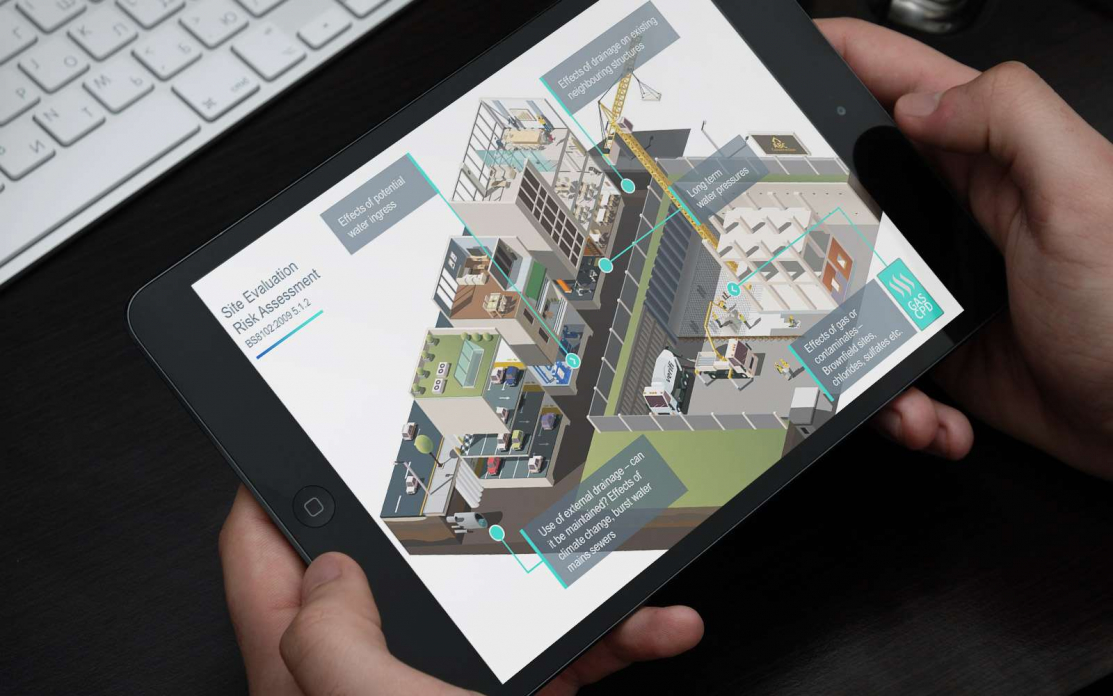
How Long Does an Interactive Touchscreen for Advanced Manufacturing Take to Develop?
Read
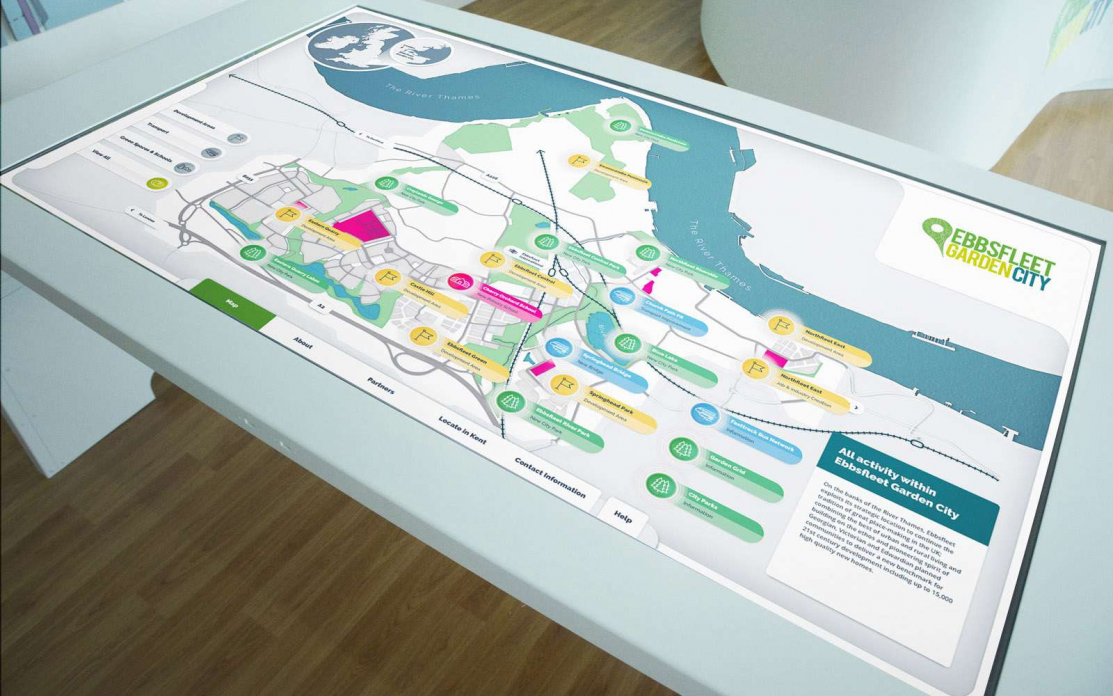
How to Deliver a More Personalised Customer Experience
Read

How to Start Meaningful B2B Sales Conversations With Your Customers
Read
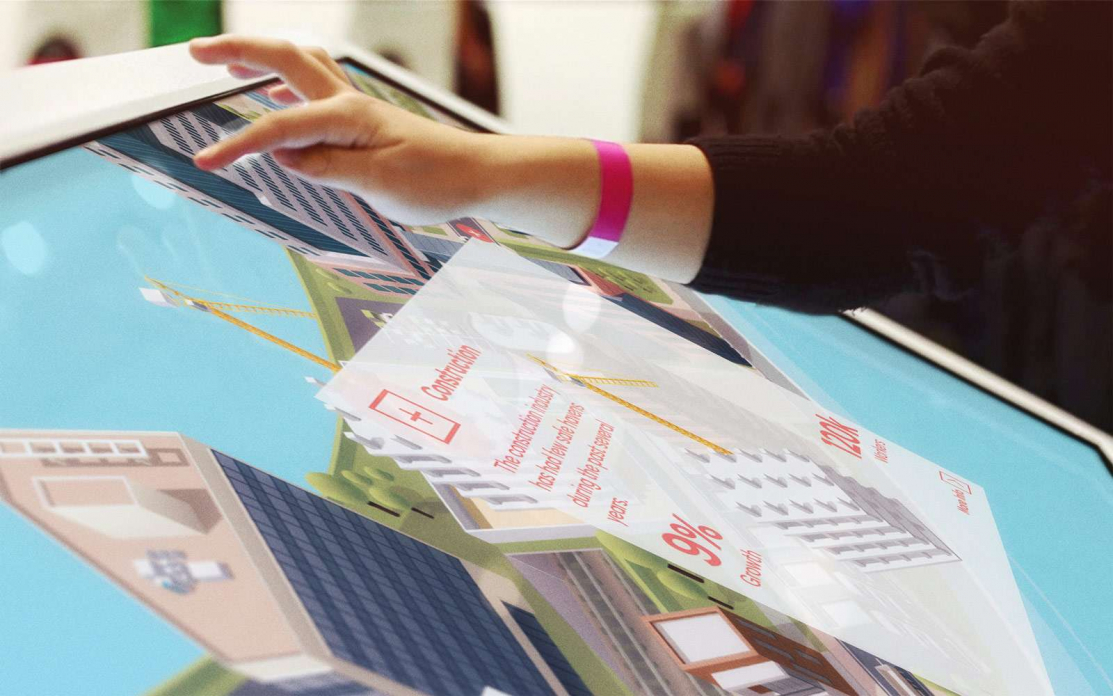
Interactive Customer Experiences for B2B Sales: How to Do It Brilliantly
Read